#Xerxes
Text
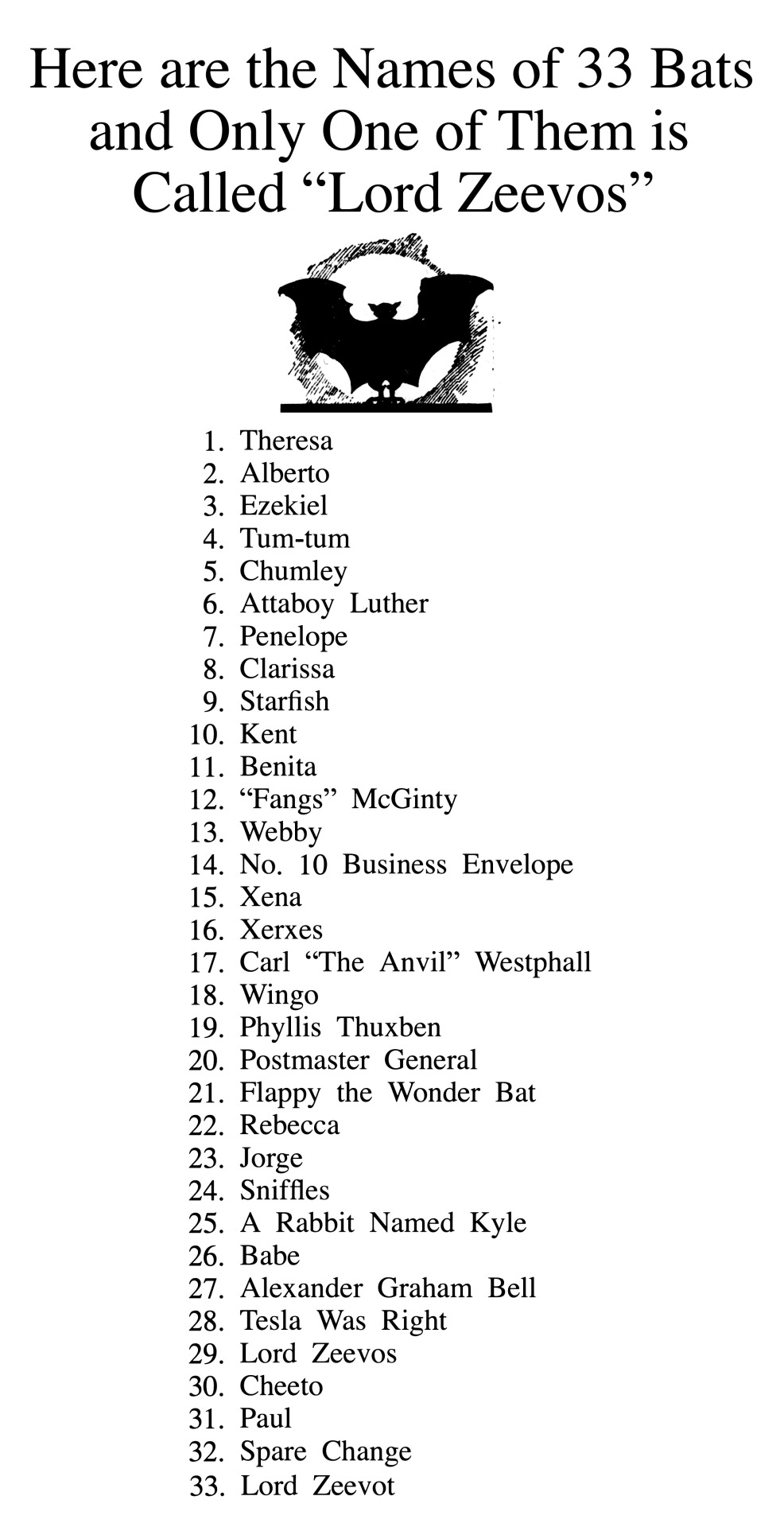
#Here are the Names of 33 Bats and Only One of Them is Called “Lord Zeevos”#bat#bats#Theresa#Alberto#Ezekiel#Tum-tum#Chumley#Attaboy Luther#Penelope#Clarissa#Starfish#Kent#Benita#“Fangs” McGinty#Webby#No. 10 Business Envelope#Xena#Xerxes#Carl “The Anvil” Westphall#Wingo#Phyllis Thuxben#Postmaster General#Flappy the Wonder Bat#Rebecca#Jorge#Sniffles#A Rabbit Named Kyle#Babe#Alexander Graham Bell
224 notes
·
View notes
Text

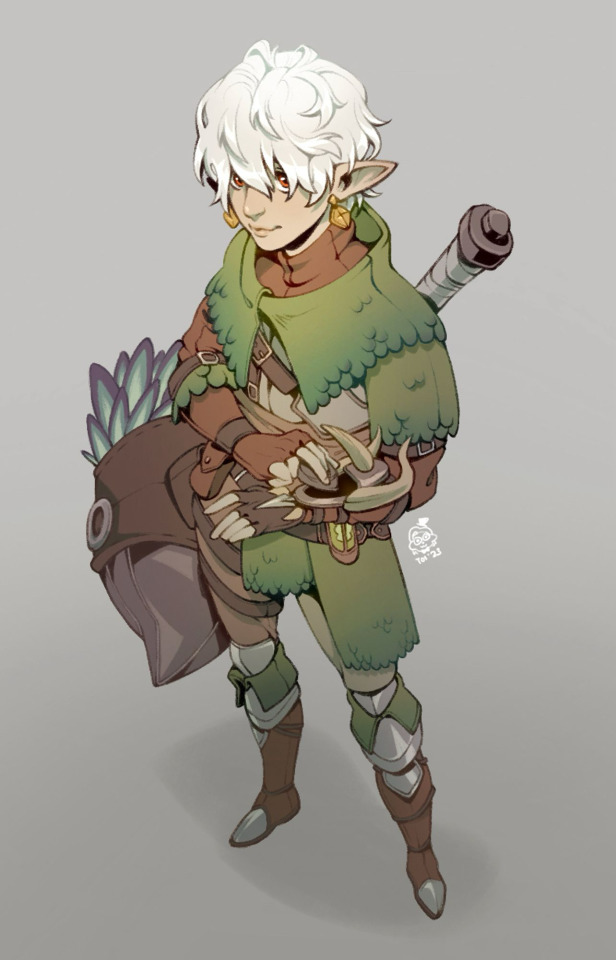
Drew my MHR and MHW hunters (I am physically incapable of not maining hammer)
210 notes
·
View notes
Text
Celebrating Vnc's return by drawing Pandora Hearts

474 notes
·
View notes
Text
there’s a lot of appreciation for morally grey characters out there but there’s truly nothing better than a character who is just a foil for themselves……like…..just fronting themselves out to other characters as something they’re absolutely not……those who laugh loudly when they don’t mean it, who clasp another’s hands out of pre-rehearsed duty and those whose smiles don’t reach their eyes, and not necessarily for nefarious reasons either….. varied shades of their personality shown to the audience only thru the different perspectives of their interactions until we ourselves aren’t sure what their real motives are and who they really are. True identity grayness, if you will.
#lets see ….#xerxes#pandora hearts#xerxes break#jack vessalius#vanitas#vanitas no carte#makima#chainsaw man#chrollo lucilfer#chrollo#jun mochizuki#claude#fire emblem#douma#douma kny#claude von riegan#claude fire emblem#dimitri#fe3h dimitri#dimitri fire emblem#dimitri alexandre blaiddyd#oz vessalius#piofiore#yang piofiore#hawks bnha
1K notes
·
View notes
Text

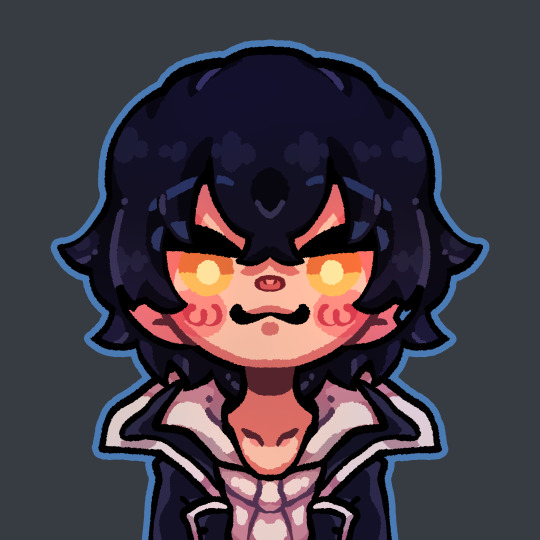


any pandora heart fans around?? 👀
i cant find people who read and love it as much as i doooo 😭
89 notes
·
View notes
Text
I remembered I haven't done up something for Xerxes au Ed. I used some inspiration from some art and canon stuff I found on Google.
It's almost the same at the King's sort??
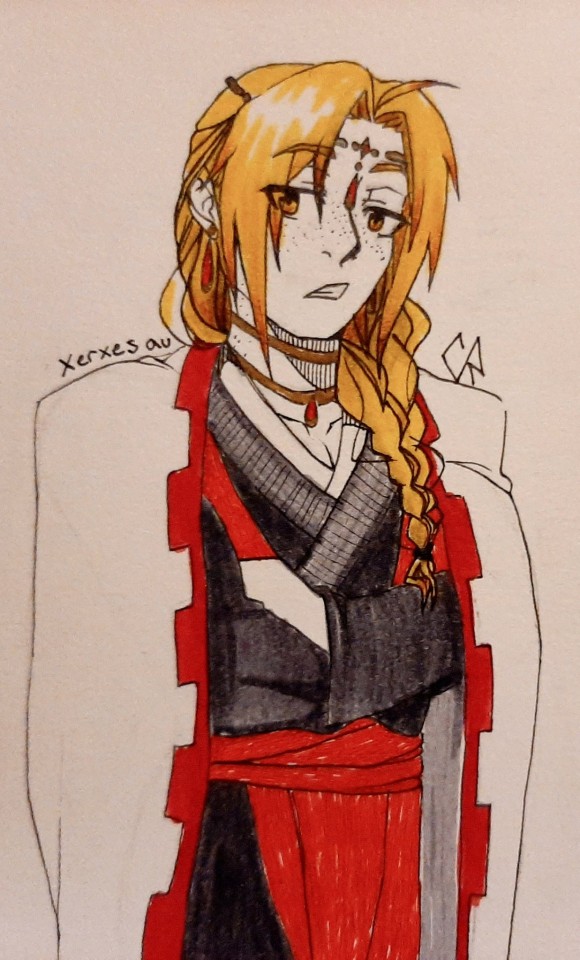
#my doodles#fma#fullmetal alchemist#edward elric#doodles#my art#freckles#drawing prompt#fma art#fma fanart#xerxes au#xerxes
56 notes
·
View notes
Text
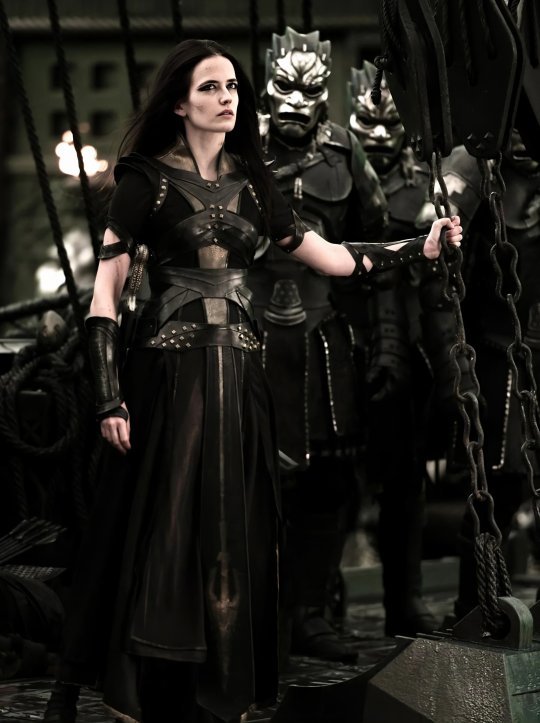
300: Rise Of An Empire (2014)
#2014#film#movie#comics#300: Rise Of An Empire#300#Rise Of An Empire#Frank Miller#Eva Green#Artemisia#Ben Turner#General Artaphernes#Sullivan Stapleton#Themistocles#Rodrigo Santoro#Xerxes#Lena Headey#Queen Gorgo#Sparta#Athen#Persian Empire#Salamis#480 BC
79 notes
·
View notes
Text
Do you remember your name?
814 words | Xerxes & Nor (timeline)
Content | Pet whump, collar, crying, referenced: Stockholm syndrome, abuse, death
Notes | Xerxes has grown too fond of their pet, and it caused some unpleasant realizations.
Taglist | @castielamigos-whump-side-blog @melancholy-in-the-morning @snakebites-and-ink

Xerxes hadn’t acquired a new project in half a year.
Of course, Pet wasn’t complaining. He had forced himself, over the years, to tune out the wailing and begging and silent suffering every new trainee went through until they learned their place, knowing there was nothing he could do to help, but he had certainly never enjoyed it.
It was kind of nice, if he was honest, to just exist along with Xerxes. Their tendency of using him as a punching bag when they were bored or having a bad day had already been in decline, and the little humiliations of everyday life as a pet barely registered anymore. Sometimes they just sat and chatted. Sometimes Pet even ventured an opinion.
Still, the fact Xerxes had, by all appearances, given up on their profession seemed like a symptom of something Pet couldn’t quite pinpoint, even after knowing them for so long. Money wasn’t an issue; by now, at the height of their success, they were rich enough to take a year or several off if they so desired. But he caught them staring into nothing, or observing him with unusual thoughtfulness, as if they were grappling with something in their head they weren’t used to.
For a while, he worried they might be ill, and wrapping up their life in the knowledge of an approaching end. Yes, worried; maybe this was that Stockholm syndrome people always talked about, but after all, he had lived with this person for years and years. He’d never liked the way he had grown fond of them, but he couldn’t simply cut it out. And if they died, what would become of him?
So when they invited him to sit at the table with them for lunch that day, an otherwise ordinary day that warranted no such treats, he was prepared for anything.
He kept stealing glances at them as they both ate. They kept silent, staring onto their plate as if avoiding his eyes. It felt wrong; they shouldn’t act this way towards their pet.
He was halfway to plucking up the courage to straight-up ask them what was up when the entire meal had passed in silence, but that was when they put a hand on his wrist, to stop him from clearing the table, and finally looked up.
»Do you remember your name?«
Pet had, he realized as quickly as if he had been slapped, not been prepared for anything.
This being a test didn’t seem to line up with things had been in the past months, even years. He did remember his name, yes; it just seemed strangely foreign now, like the name of an acquaintance from the past. He had tried to hold on to it as his own for a while, but ultimately, Xerxes won. Of course they did.
»Yes, Master,« he replied cautiously.
Xerxes kept looking at him, and Pet - who was, as he was now reminded, once Nor - was startled at the shine in their eyes. They weren’t - those weren’t tears, were they?
»That’s good.« They sounded miserable. Defeated. They fished something out of their pocket, and leant over. Before he could make sense of what was happening, their warm hands were on his collar, and it was mere moments before the little lock opened with the tiniest click.
»What are you doing?« Pet blurted out.
Yes, those were definitely tears, even if they weren’t spilling over yet.
»You can go.«
»To where?!«
Xerxes chuckled wetly, and lowered their eyes again. »Wherever you want. You - you can stay until you figure it out, of course. But… you’re free.«
Free. The word bounced through his head, fluttered in his chest. It seemed unreal. He hadn’t even bothered to wish he were free in ages.
And yet…
Abruptly he got up and walked out the room. Walked down the hall, past the basement door that still made his heart beat faster. Up to the front door.
Touching it was forbidden, he knew that with every fibre of his body. His skin prickled, almost painfully, when he reached out to the key, in the lock as always.
He didn’t know how, but then moments later the door was open, and he stood in the yard. The guard sitting on the front porch looked at him—and made no move to stop him when he went over to the driveway, looking down the hill.
His vision blurred.
He barely could put a name to the emotions that brought the tears—there were too many, too overwhelming. His whole life was about to change; he would—would he? Would he have the nerve to leave everything he knew behind?
He wiped off his tears.
He didn’t have shoes. Regardless of what he was going to do next, there were still things to be sorted.
Gingerly, as if walking on eggshells, he went back to the house.
#whump#whump writing#pet whump#my writing#xerxes#nor#the sink#an whump writing! from me!#and a big plot point too
39 notes
·
View notes
Text
Was Xerxes an isolationist-ethnostate? Why?
This may sound like a weird question but it's something that has been bothering me for a while. Whenever we see Xerxes everyone pretty much looks the same. Golden hair, golden eyes, light skin. We know there was a Xing-Xerxes-Amestris train and caravans of Xing merchants back then. Still we don't see a single non-Xerxian in the flashbacks or within Father's and Hohenheim's philosopher stones.

This has led me to believe that Xerxes' must have been an isolationist-ethnostate. Here is my reasoning:
Neither Amestris nor Xing had alchemy before Father and Hohenheim taught them, and in present FMA alchemy is rare enough that only Amestris has military use of it. Meanwhile, Xerxes is presented as having alchemy knowledge that even present Amestris lacks. That must mean Xerxes' discovered Alchemy, somehow, and kept that knowledge for themselves alone. That could explain why there isn't a single foreigner in the flashbacks. People from the "lesser" nations must have been forbidden entrance in order to keep the secrets of Alchemy safe.
This also explains why we see the Xing merchants that save Hohenheim walking so far away from Xerxes, even though there was a train connecting both nations. It's entirely possible the trains were only to carry precious cargo from the subjugated nations into Xerxes, who would have many needs considering they live in a desert. This would also explain why the train line was completely neglected after Xerxes fall. If it was Xerxes running it (perhaps with alchemy) and only for their own benefit neither Amestris nor Xing would have the means nor want to keep it running.
Lastly, considering how lunatic King Xerxes seemed, him being deadly afraid of anyone else getting the knowledge of alchemy sounds perfectly on brand for him.
144 notes
·
View notes
Text
Countries that are no more: Achaemenid Empire (550BC-330BC)
It was not the first empire of Iranian peoples, but it arose as probably the greatest in terms of influence and became the measure by which all subsequent Iranian empires tended to compare themselves and its influence on culture, government & civil infrastructure would influence others beyond the span of its territory and the span of time. This is the Achaemenid Empire.
Name: In Old Persian it was known as Xšāça or the "The Kingdom or the Empire", it was named the Achaemenid Empire by later historians. Named after the ruling dynasty established by its founder Cyrus the Great who cited the name of his ancestor Haxāmaniš or Achaemenes in Greek as progenitor of the dynasty. It is sometimes also referred to as the First Persian Empire. The Greeks simply referred to it as Persia, the name which stuck for the geographic area of the Iranian plateau well into the modern era.
Language: Old Persian & Aramaic were the official languages. With Old Persian being an Iranian language that was the dynastic language of the Achaemenid ruling dynasty and the language of the Persians, an Iranian people who settled in what is now the southwestern Iranian plateau or southwest Iran circa 1,000 BC. Aramaic was a Semitic language that was the common and administrative language of the prior Neo-Assyrian & Neo-Babylonian Empires which centered in Mesopotamia or modern Iraq, Syria & Anatolian Turkey. After the Persian conquest of Babylon, the use of Aramaic remained the common tongue within the Mesopotamian regions of the empire, eventually becoming a lingua franca across the land. As the empire spread over a vast area and became increasingly multiethnic & multicultural, it absorbed many other languages among its subject peoples. These included the Semitic languages Akkadian, Phoenician & Hebrew. The Iranian language of Median among other regional Iranian languages (Sogdian, Bactrian etc). Various Anatolian languages, Elamite, Thracian & Greek among others.
Territory: 5.5 million kilometers squared or 2.1 million square miles at its peak circa 500BC. The Achaemenid Empire spanned from southern Europe in the Balkans (Greece, Bulgaria, European Turkey) & northwest Africa (Egypt, Libya & Sudan) in the west to its eastern stretches in the Indus Valley (Pakistan) to parts of Central Asia in the northeast. It was centered firstly in the Iranian Plateau (Iran) but also held capitals in Mesopotamia (Iraq). Territory was also found in parts of the Arabian Peninsula & the Caucausus Mountains.
Symbols & Mottos: The Shahbaz or Derafsh Shahbaz was used as the standard of Cyrus the Great, founder of the empire. It depicts a bird of prey, typically believed to be a falcon or hawk (occasionally an eagle) sometimes rendered gold against a red backdrop and depicts the bird holding two orbs in its talons and adorned with an orb likewise above its head. The symbolism was meant to depict the bird guiding the Iranian peoples to conquest and to showcase aggression & strength coupled with dignity. The imperial family often kept falcons for the pastime of falconry.
Religion: The ancient Iranian religion of Zoroastrianism served as the official religion of the empire. It was adopted among the Persian elite & and had its unique beliefs but also helped introduce the concept of free-will among its believers, an idea to influence Judaism, Christianity & Islam in later centuries. Despite this official religion, there was a tolerance for local practices within the subject regions of the empire. The ancient Mesopotamian religion in Babylon & Assyria, Judaism, the Ancient Greek & Egyptian religions & Vedic Hinduism in India was likewise tolerated as well. The tolerance of the Achaemenids was considered a relative hallmark of their dynasty from the start. Famously, in the Old Testament of the Bible it was said that it was Cyrus the Great who freed the Jews from their Babylonian captivity and allowed them to return to their homeland of Judea in modern Israel.
Currency: Gold & silver or bimetallic use of coins became standard within the empire. The gold coins were later referred to as daric and silver as siglos. The main monetary production changes came during the rule of Darius I (522BC-486BC). Originally, they had followed the Lydian practice out of Anatolia of producing coins with gold, but the practice was simplified & refined under the Achaemenids.
Population: The estimates vary ranging from a low end of 17 million to 35 million people on the upper end circa 500BC. The official numbers are hard to determine with certainty but are generally accepted in the tens of millions with the aforementioned 17-35 million being the most reasonable range based on available sources.
Government: The government of the Achaemenid Empire was a hereditary monarchy ruled by a king or shah or later referred to as the ShahanShah or King of Kings, this is roughly equivalent to later use of the term Emperor. Achaemenid rulers due the unprecedented size of their empire held a host of titles which varied overtime but included: King of Kings, Great King, King of Persia, King of Babylon, Pharaoh of Egypt, King of the World, King of the Universe or King of Countries. Cyrus the Great founded the dynasty with his conquest first of the Median Empire and subsequently the Neo-Babylonians and Lydians. He established four different capitals from which to rule: Pasargadae as his first in Persia (southwest central Iran), Ecbatana taken from the Medians in western Iran's Zagros Mountains. The other two capitals being Susa in southwest Iran near and Babylon in modern Iraq which was taken from the Neo-Babylonians. Later Persepolis was made a ceremonial capital too. The ShahanShah or King of Kings was also coupled with the concept of divine rule or the divinity of kings, a concept that was to prove influential in other territories for centuries to come.
While ultimate authority resided with the King of Kings and their bureaucracy could be at times fairly centralized. There was an expansive regional bureaucracy that had a degree of autonomy under the satrapy system. The satraps were the regional governors in service to the King of Kings. The Median Empire had satraps before the Persians but used local kings they conquered as client kings. The Persians did not allow this because of the divine reverence for their ShahanShah. Cyrus the Great established governors as non-royal viceroys on his behalf, though in practice they could rule like kings in all but name for their respective regions. Their administration was over their respective region which varied overtime from 26 to 36 under Darius I. Satraps collected taxes, acted as head over local leaders and bureaucracy, served as supreme judge in their region to settle disputes and criminal cases. They also had to protect the road & postal system established by the King of Kings from bandits and rebels. A council of Persians were sent to assist the satrap with administration, but locals (non-Persian) could likewise be admitted these councils. To ensure loyalty to the ShahanShah, royal secretaries & emissaries were sent as well to support & report back the condition of each satrapy. The so called "eye of the king" made annual inspections of the satrapy to ensure its good condition met the King of Kings' expectations.
Generals in chief were originally made separate to the satrap to divide the civil and military spheres of government & were responsible for military recruitment but in time if central authority from the ShahanShah waned, these could be fused into one with the satrap and general in chiefs becoming hereditary positions.
To convey messages across the widespread road system built within the empire, including the impressive 2,700 km Royal Road which spanned from Susa in Iran to Sardis in Western Anatolia, the angarium (Greek word) were an institution of royal messengers mounted on horseback to ride to the reaches of the empire conveying postage. They were exclusively loyal to the King of Kings. It is said a message could be reached to anywhere within the empire within 15 days to the empire's vast system of relay stations, passing message from rider to rider along its main roads.
Military: The military of the Achaemenids consisted of mostly land based forces: infantry & cavalry but did also eventually include a navy.
Its most famous unit was the 10,000-man strong Immortals. The Immortals were used as elite heavy infantry were ornately dressed. They were said to be constantly as 10,000 men because for any man killed, he was immediately replaced. Armed with shields, scale armor and with a variety of weapons from short spears to swords, daggers, slings, bows & arrows.
The sparabara were the first line of infantry armed with shields and spears. These served as the backbone of the army. Forming shield walls to defend the Persian archers. They were said to ably handle most opponents and could stop enemy arrows though their shields were vulnerable to enemy spears.
There was also the takabara light infantry and though is little known of them it seems they served as garrison troops and skirmishers akin to the Greek peltast of the age.
The cavalry consisted of four distinct groups: chariot driven archers used to shoot down and break up enemy formations, ideally on flat grounds. There was also the traditional horse mounted cavalry and also camel mounted cavalry, both served the traditional cavalry functions and fielded a mix of armor and weapons. Finally, there was the use of war elephants which were brought in from India on the empire's eastern reaches. These provided archers and a massive way to physically & psychologically break opposing forces.
The navy was utilized upon the empire's reaching the Mediterranean and engaged in both battles at sea and for troop transport to areas where troops needing deploying overseas, namely in Greece.
The ethnic composition of Achaemenid military was quite varied ranging from a Persian core with other Iranian peoples such as the Medians, Sogdian, Bactrians and Scythians joining at various times. Others including Anatolians, Assyrians, Babylonians, Anatolians, Indians, Arabs, Jews, Phoenicians, Thracians, Egyptians, Ethiopians, Libyans & Greeks among others.
Their opponents ranged from the various peoples they conquered starting with the Persian conquest of the Medians to the Neo-Babylonians, Lydians, Thracians, Greeks, Egyptians, Arabs & Indians and various others. A hallmark of the empire was to allow the local traditions of subjugated areas to persist so long as garrisons were maintained, taxes were collected, local forces provided levies to the military in times of war, and they did not rebel against the central authority.
Economy: Because of the efficient and extensive road system within the vast empire, trade flourished in a way not yet seen in the varied regions it encompassed. Tax districts were established with the satrapies and could be collected with relative efficiency. Commodities such as gold & jewels from India to the grains of the Nile River valley in Egypt & the dyes of the Phoenicians passed throughout the realm's reaches. Tariffs on trade & agricultural produce provided revenue for the state.
Lifespan: The empire was founded by Cyrus the Great circa 550BC with his eventual conquest of the Median & Lydian Empires. He started out as Cyrus II, King of Persia a client kingdom of the Median Empire. His reign starting in 559BC. Having overthrown and overtaken the Medians, he turned his attention Lydia and the rest of Anatolia (Asia Minor). He later attacked the Eastern Iranian peoples in Bactria, Sogdia and others. He also crossed the Hindu Kush mountains and attacked the Indus Valley getting tribute from various cities.
Cyrus then turned his attention to the west by dealing with the Neo-Babylonian Empire. Following his victory in 539BC at the Battle of Opis, the Persians conquered the Babylonia with relative quickness.
By the time of Cyrus's death his empire had the largest recorded in world history up to that point spanning from Anatolia to the Indus.
Cyrus was succeeded by his sons Cambyses II and Bardiya. Bardiya was replaced by his distant cousin Darius I also known as Darius the Great, whose lineage would constitute a number of the subsequent King of Kings.
Darius faced many rebellions which he put down in succession. His reign is marked by changes to the currency and the largest territorial expansion of the empire. An empire at its absolute zenith. He conquered large swaths of Egypt, the Indus Valley, European Scythia, Thrace & Greece. He also had exploration of the Indian Ocean from the Indus River to Suez Egypt undertaken.
The Greek kingdom of Macedon in the north reaches of the Hellenic world voluntarily became a vassal of Persia in order to avoid destruction. This would prove to be a fateful first contact with this polity that would in time unite the Greek-speaking world in the conquest of the Achaemenid Empire. However, at the time of Darius I's the reign, there were no early indications of this course of events as Macedon was considered even by other Greek states a relative backwater.
Nevertheless, the Battle of Marathon in 490BC halted the conquest of mainland Greece for a decade and showed a check on Persia's power in ways not yet seen. It is also regarded as preserving Classical Greek civilization and is celebrated to this day as an important in the annals of Western civilization more broadly given Classical Greece & in particular Athens's influence on western culture and values.
Xerxes I, son of Darius I vowed to conquer Greece and lead a subsequent invasion in 480BC-479BC. Xerxes originally saw the submission of northern Greece including Macedon but was delayed by the Greeks at the Battle of Thermopylae, most famously by Spartan King Leonidas and his small troop (the famed 300). Though the Persians won the battle it was regarded as a costly victory and one that inspired the Greeks to further resistance. Though Athens was sacked & burnt by the Persians, the subsequent victories on sea & land at Salamis & Plataea drove the Persians back from control over Greece. Though war would rage on until 449BC with the expulsion of the Persians from Europe by the Greeks.
However, the Greeks found themselves in a civil war between Athens & Sparta and Persia having resented the Athenian led coalition against their rule which had expelled them from Europe sought to indirectly weaken the Greeks by supporting Greek factions opposed to Athens through political & financial support.
Following this reversal of fortune abroad, the Achaemenid Empire not able to regain its foothold in Europe, turned inward and focused more on its cultural development. Zoroastrianism became the de-facto official religion of the empire. Additionally, architectural achievements and improvements in its many capitals were undertaken which displayed the empire's wealth. Artaxerxes II who reigned from 405BC-358BC had the longest reign of any Achaemenid ruler and it was characterized by relative peace and stability, though he contended with a number of rebellions including the Great Satraps Revolt of 366BC-360BC which took place in Anatolia and Armenia. Though he was successful in putting down the revolt. He also found himself at war with the Spartans and began to sponsor the Athenians and others against them, showcasing the ever dynamic and changing Greco-Persian relations of the time.
Partially for safety reasons, Persepolis was once again made the capital under Artaxerxes II. He helped expand the city and create many of its monuments.
Artaxerxes III feared the satraps could no longer be trusted in western Asia and ordered their armies disbanded. He faced a campaign against them which suffered some initial defeats before overcoming these rebellions, some leaders of which sought asylum in the Kingom of Macedon under its ruler Philip II (father of Alexander the Great).
Meanwhile, Egypt had effectively become independent from central Achaemenid rule and Artaxerxes III reinvaded in around 340BC-339BC. He faced stiff resistance at times but overcame the Egyptians and the last native Egyptian Pharaoh Nectanebo II was driven from power. From that time on ancient Egypt would be ruled by foreigners who held the title Pharaoh.
Artaxerxes III also faced rebellion from the Phoenicians and originally was ejected from the area of modern coastal Lebanon, Syria & Israel but came back with a large army subsequently reconquered the area including burning the Phoenician city of Sidon down which killed thousands.
Following Artaxerxes III's death his son succeeded him but a case of political intrigue & dynastic murder followed. Eventually Darius III a distant relation within the dynasty took the throne in 336BC hoping to give his reign an element of stability.
Meanwhile in Greece, due to the military reforms and innovations of Philip II, King of Macedon, the Greek speaking world was now unified under Macedon's hegemony. With Philip II holding the title of Hegemon of the Hellenic League, a relatively unified coalition of Greek kingdoms and city-states under Macedon premiership that formed to eventually invade Persia. However, Philip was murdered before his planned invasion of Asia Minor (the Achaemenid's westernmost territory) could commence. His son Alexander III (Alexander the Great) took his father's reforms and consolidated his hold over Greece before crossing over to Anatolia himself.
Darius III had just finished reconquering some rebelling vestiges of Egypt when Alexander army crossed over into Asia Minor circa 334BC. Over the course of 10 years Alexander's major project unfolded, the Macedonian conquest of the Persian Empire. He famously defeated Persians at Granicus, Issus and Gaugamela. The latter two battles against Darius III in person. He took the King of Kings family hostage but treated them well while Darius evacuated to the far eastern reaches of his empire to evade capture. He was subsequently killed by one of his relatives & satraps Bessus, whom Alexander eventually had killed. Bessus had declared himself King of Kings though this wasn't widely recognized and most historians regard Darius III, the last legitimate ShahanShah of Achaemenids.
Alexander had taken Babylon, Susa & Persepolis by 330BC and effectively himself was now ruler of the Persian Empire or at least its western half. In addition to being King of Macedon & Hegemon of the Hellenic League, he gained the titles King of Persia, Pharaoh of Egypt & Lord of Asia. Alexander would in time eventually subdue the eastern portions of the Achaemenid realm including parts of the Indus Valley before turning back to Persia and Babylon where he subsequently became ill and died in June 323BC at age 32. Alexander's intentions it appears were never to replace the Achaemenid government & cultural structure, in fact he planned to maintain and hybridize it with his native Greek culture. He was in fact an admirer of Cyrus the Great (even restoring his tomb after looting) & adopted many Persian customs and dress. He even allowed the Persians to practice their religion and had Persian and Greeks start to serve together in his army. Following his death and with no established successor meant the empire he established which essentially was the whole Achaemenid Empire's territory in addition to the Hellenic world fragmented into different areas run by his most trusted generals who established their own dynasties. The Asian territories from Anatolia to the Indus (including Iran and Mesopotamia) gave way to the Hellenic ruled Seleucid Empire while Egypt became the Hellenic ruled Ptolemaic Kingdom. The synthesis of Persian and Greek cultures continued in the Seleucid and Greco-Bactrian kingdoms of antiquity.
The Achaemenid Empire lasted for a little over two centuries (550BC-330BC) but it casted a long shadow over history. Its influence on Iran alone has persisted into the modern age with every subsequent Persian Empire claiming to be its rightful successor from the Parthian & Sasanian Empires of pre-Islamic Iran to the Safavids of the 16th-18th century and the usage of the title Shah until the last Shah's ejection from power in the 1979 Islamic Revolution. Even the modern Islamic Republic of Iran uses Achaemenid imagery in some military regiments and plays up its importance in tourism and museums as a source of pride to Persian (Farsi) & indeed Iranian heritage. Likewise, its form of governance and the pushing of the concept of divine rights of kings would transplant from its Greek conquerors into the rest of Europe along with various other institutions such as its road & mail system, tax collection & flourishing trade. Its mix of centralized & decentralized governance. Its religious & cultural tolerance of local regions even after their conquest would likewise serve as a template for other empires throughout history too. The Achaemenid Empire served as a template for vast international & transcontinental empires that would follow in its wake & surpass its size & scope of influence. However, it is worth studying for in its time, it was unprecedented, and its innovations so admired by the likes of Alexander the Great and others echo into the modern era.
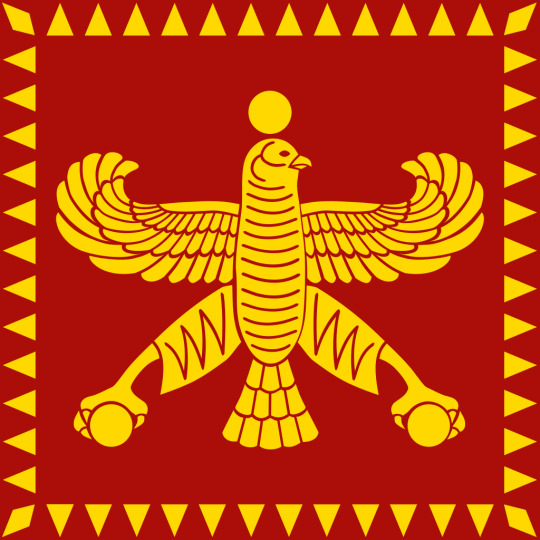
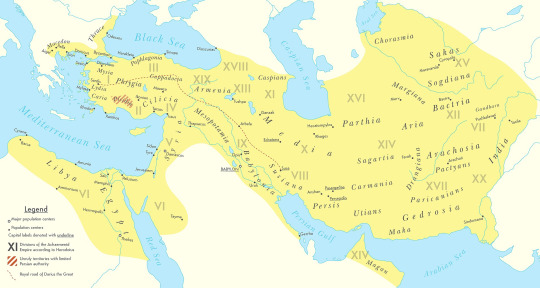


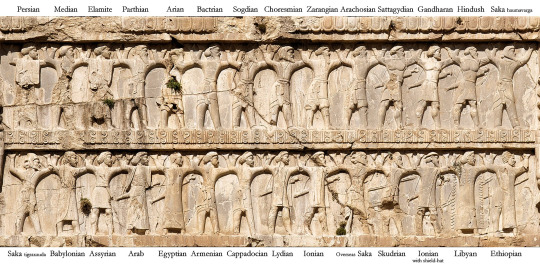
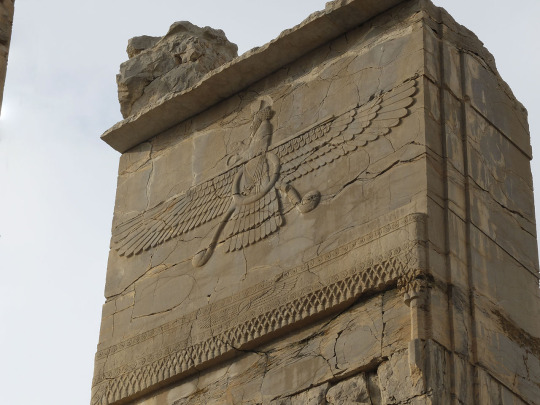




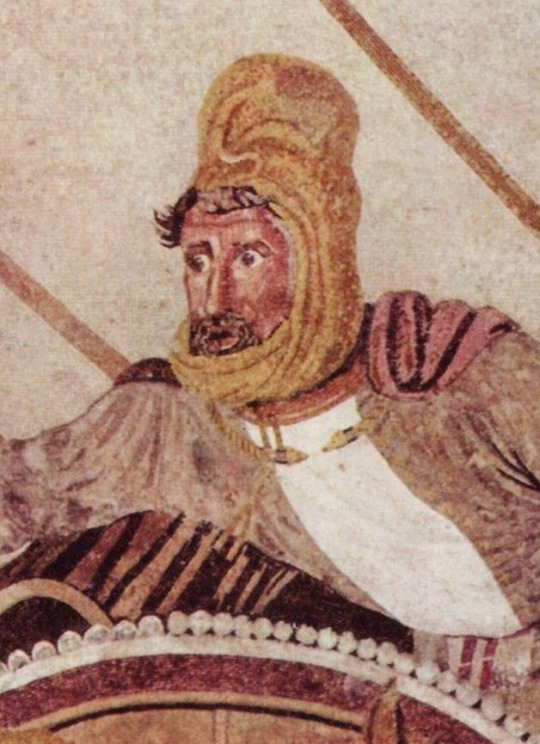
#military history#antiquity#iran#greece#ancient greece#classical greece#ancient ruins#ancient iran#ancient persia#achaemenid#persia#zoroastrianism#alexander the great#cyrus the great#xerxes#artwork#government#history#persian empire#ancient egypt
89 notes
·
View notes
Text

Marcos Castro (Mexican, 1981) - Xerxes Whips the Sea (2019)
63 notes
·
View notes
Text
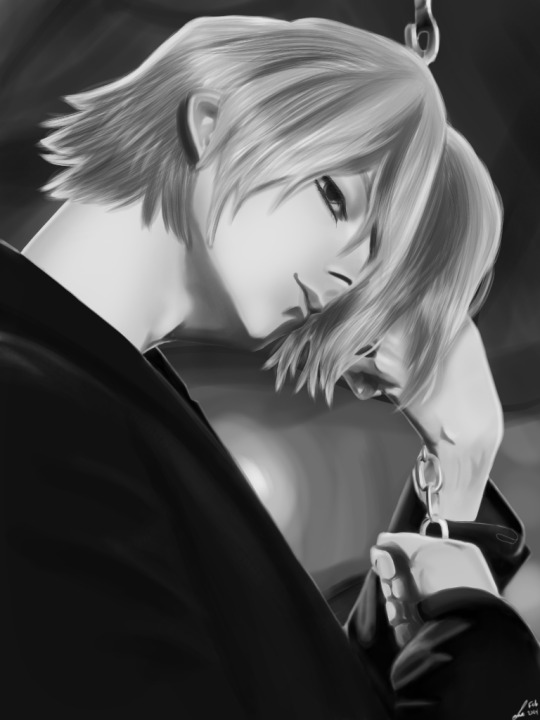
Semi realistic Break because I'm single-handedly trying to will this man into existence.
#pandora hearts#pandora hearts fanart#xerxes break#xerxes#break#fanart#digital art#my art#greyscale#semirealism#artists on tumblr#art#black and white#art milestone#sobs#i love him
23 notes
·
View notes
Text

I participated in another community event - Tiefling Secret Satan 2023! I got to draw Xerxes, a character of @maikuuro! Your lad is delightful and I had so much fun drawing him! 🌹✨
You can also find Mai on insta at the same handle, @/maikuuro! Go check out her art!
#tieflingsecretsatan2023#tiefling secret satan 2023#TSS 2023#fan art#tiefling#xerxes#maikuuro#digital#procreate#love this lad!!!!!!!!! very good very exceptional
84 notes
·
View notes
Text

He’s 6 years old now 🎉
23 notes
·
View notes
Text

Discover Xerxes - the golden city
An eternal piece of history.
Second FMA vintage travel poster 🧡 [Amestris]
#fma#fmab#fullmetal alchemist#fullmetal alchemist brotherhood#fma fanart#xerxes#make good art#make fan art#digital media#digital painting#100#portfolio
108 notes
·
View notes
Text
Timeline
A timeline of every time a Spacelander has visited Flatland! Starting with...


Flatland's Year 0!
My friend @frau-line had the idea of a messiah and an apostle that fell in love and lived in Spaceland together. I also saw an idea for a god myth that included a picture of a sphere with a line orbiting around it and thought that that was a banger design for a god(s). Though I cant for the life of me find it now... its a small fandom I'll see it eventually.
With that out of the way, heres these two nameless but lovely ladies. I think at this point Flatland would be in like, caveman times or something, but the line is a fast learner and quickly absorbed all information that the sphere gave her.
As for Spacelands society, theyre far ahead of Flatland, but still not nearly as technologically advanced as they are in the film. Maybe like aztec times...?
Theyve just found Flatland and know exactly nothing about it. They sent the sphere to go check it out, and when she came back a month later they had a Flatlander with them.
They study the line and Flatland and they find out... something... that makes it so they set a concrete rule to only ever visit once every thousand years to impart knowledge upon the primitive Flatlanders.
I have no idea why they decide to do this every 1000 years. Perhaps the line dies shortly after her ascension to Spaceland (due to gravitational forces) and the sphere is heartbroken and bitter and shes like "Flatland is extremely fragile we must only interact with it rarely or we will FUCK UP and KILL things"


Year 1000
frau-line fuels this scenario and the next as well. Her ideas are some of the most interesting and compelling I've seen so its hard not to steal :P
The messiah of the Year 1000 wasnt exactly thrilled to do this job, but the first official visit was something highly anticipated and that he was specifically taught to do, so he studied hard and practiced well. He thought it easy and simple until, well...
Unfortunately, the year 1000 apostle must have been at least a little unhinged before enlightenment, so this messiahs mission went wildly off the rails. As soon as he finished his geometry homework, he started a massive country-wide riot, and martyred himself before anyone could ask what he was rioting for.
As for his shape I think he was either a hexagon or an octagon i cant remember im so sorry frau line 😖😖😖
Any fucking ways the messiah is like

And he has some like. Idk not trauma, but he is a little fucked up by it and thinks he should have taken it more seriously or whatever. Who cares though


Year 2000
Saturnius and Areia. Thanking frau-line every day for creating these guys, their plot is so captivating and I have a huge soft spot for Ariea specifically.
Saturnius is a noble sphere prince that takes his job deathly seriously, and Areia is a low class line determined to spread the gospel no matter the cost. The cost ends up being a holy war that is far more destructive than the year 1000 apostle could have even imagined...
Nothing I could say about them could live up to Suovetaurilia, so please give it a read!


Year 3000
You know who these guys are.

Year 4000
Finally, my home grown boys!
Xerxes is very lacking in the self confidence department and is trying to be the best most effective messiah to date to prove himself. His hopes are shattered when he happens to pick Claude, an average pentagon working an average 9-5 job, who doesn't give a singular shit about the third dimension at all. Xerxes doesn't give up easily, and secretly interacts with Claude even after the millennial visit in order to convince Claude to become an apostle. Unfortunately, it turns out Claude is just as stubborn.
...And thats all I have! This is all just my personal headcanon, so I'd really love to hear what you all think the timeline looks like!!
27 notes
·
View notes